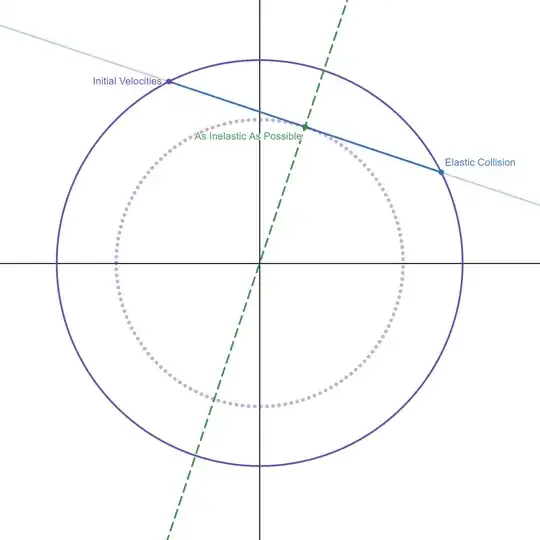As far as I can tell, what we need here is an intuitive understanding rather than a mathematical one. The intuition gets a bit blurred by the mathematical expressions. But, if we take the two colliding bodies to be of equal mass, the expressions get greatly simplified. While not immediately obvious, the results apply to arbitrary combinations of masses.
Let me mass in question be $m$. If we call the initial velocities of the two bodies $\vec{v_1}$ and $\vec{v_2}$, and the final velocities $\vec{v_1'}$ and $\vec{v_2'}$ respectively, our only constraint is that momentum must be conserved. So:
$m \vec{v_1} + m \vec{v_2} = m \vec{v_1'} + m \vec{v_2'}$
Since we took the masses to be equal, this immediately reduces to:
$\vec{v_1} + \vec{v_2} = \vec{v_1'} + \vec{v_2'}$
Now, the velocity of the center of mass (sometimes we call it center of momentum, especially when dealing with relativistic systems) which we will call $\vec{V}$ is:
$ \vec{V} = \frac{m \vec{v_1} + m \vec{v_2}}{m + m}$
Again, by virtue of equal masses readily reduces to:
$ \vec{V} = \frac{\vec{v_1} + \vec{v_2}}{2}$
If we transform the initial velocities to this new frame, and call the respective initial velocities of the bodies in this (center of mass) frame $\vec{u_1}$ and $\vec{u_2}$, they are:
$\vec{u_1} = \vec{v_1} - \vec{V}$
$\vec{u_2} = \vec{v_2} - \vec{V}$
Substitiution of the expression for $\vec{V}$ yields:
$\vec{u_1} = \vec{v_1} - \frac{\vec{v_1} + \vec{v_2}}{2}$
$\vec{u_2} = \vec{v_2} - \frac{\vec{v_1} + \vec{v_2}}{2}$
Simplification leads to:
$\vec{u_1} = \frac{\vec{v_1} - \vec{v_2}}{2}$
$\vec{u_2} = \frac{\vec{v_2} - \vec{v_1}}{2}$
Ooooh... So, $\vec{u_1}$ and $\vec{u_2}$ are equal and opposite! This suggests defition of a relative velocity:
$\vec{r} = \frac{\vec{v_1} - \vec{v_2}}{2}$
Such that now
$\vec{u_1} = \vec{r}$
$\vec{u_2} = -\vec{r}$
Why all this trouble? All this work essentially shows two things:
In the center of mass frame, the bodies have same magnitude and opposing direction velocities.
In the original frame, the velocities can be expressed as:
$\vec{v_1} = \vec{V} + \vec{r}$
$\vec{v_2} = \vec{V} - \vec{r}$
If we call the kinetic energy in the original frame $T$, we can express it as:
$T = \frac{1}{2}m v_1^2 + \frac{1}{2}m v_2^2$
Well, $v_1^2$ is $\vec{v_1}\cdot\vec{v_1}$ and $v_2^2$ is $\vec{v_2}\cdot\vec{v_2}$. So:
$T = \frac{1}{2}m (\vec{V} + \vec{r})\cdot (\vec{V} + \vec{r}) + \frac{1}{2}m (\vec{V} - \vec{r})\cdot (\vec{V} - \vec{r})$
Let us expand this crazy thing:
$T = \frac{1}{2}m (V^2 + r^2 + 2 \vec{V}\cdot\vec{r}) + \frac{1}{2}m (V^2 + r^2 - 2 \vec{V}\cdot\vec{r}) $
Here, a minor miracle occurs. There is perfect cancellation of the dot products. This perfect cancellation only occurs when $\vec{V}$ is the velocity of the center of mass; for any other frame the cross-terms will remain. As such, the center of mass frame is special. (This works just as well when the masses are not equal, just with more complicated expressions.)
Our kinetic energy expression is now:
$T = \frac{1}{2}m V^2 + \frac{1}{2}m V^2 + \frac{1}{2}m r^2 + \frac{1}{2}m r^2 $
Now, this is really cool. The kinetic energy split itself into two distinct parts. One, we can call $T_c$, which is the kinetic energy due to the motion of the center of mass which is just:
$T_c = \frac{1}{2}m V^2 + \frac{1}{2}m V^2$
The second part, which we can call $T_r$, which is the kinetic energy due to motion relative to the center of mass:
$T_r = \frac{1}{2}m r^2 + \frac{1}{2}m r^2$
And of course:
$T = T_c + T_r$
Now, let us consider what happens after the collision. In the center of mass frame (which is special, as we now know) the initial total momentum is zero ($m \vec{r} - m \vec{r} = \vec{0}$) So, the final momentum must be zero. Following the same transformation reasoning, the final velocities in the original frame can be expressed as:
$\vec{v_1'} = \vec{V} + \vec{r'}$
$\vec{v_2'} = \vec{V} - \vec{r'}$
Here, $\vec{r'}$ is the relative velocity in the final state (after the collision). With pretty much the same derivation, the final kinetic energy $T'$ can be expressed as (obviously, in the original frame):
$T' = T_c + T_r'$
$T_c = \frac{1}{2}m V^2 + \frac{1}{2}m V^2$ (exactly the same as before)
$T_r' = \frac{1}{2}m r'^2 + \frac{1}{2}m r'^2$
So, the kinetic energy due to the motion of the center of mass does not change. That is essentially due to conservation of momentum. What can change is the motion relative to the center of mass, which depends on the details (and elasticity) of the collision.
For a perfectly elastic collision,
$|\vec{r}| = |\vec{r'}|$
In general, due to conservation of energy:
$|\vec{r'}| \leq |\vec{r}|$
(Unless some energy is released from another source, but that is not what we are considering here.)
For a perfectly inelastic collision, $\vec{r'} = \vec{0}$. The kinetic energy after the collision will then just be the energy due to the motion of the center of mass - the system becomes lumped, and its "components" no longer carry any kinetic energy.
Just to re-iterate the key point: The center of mass frame is special in the sense that, the kinetic energy in any_other_reference_frame can be expressed as a sum of the kinetic energy of the center of mass in that reference frame, plus the kinetic energies of the bodies in the center of mass reference frame. So, after a collision, since you can not alter the velocity of the center of mass of a system without the action of external forces, that part of kinetic energy is fixed. What you can lose is the kinetic energy of the bodies in the system due to motion relative to the center of mass. And that happens only in the case of a perfect inelastic collision, where the bodies stick together and are motionless in the center of mass frame.
As such, that is the most kinetic energy that can be lost. QED.
